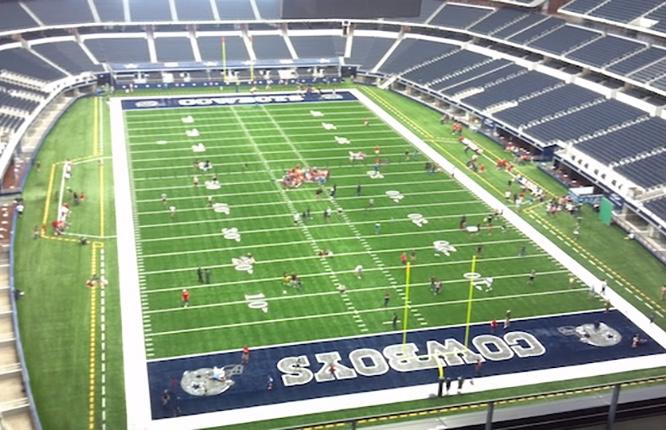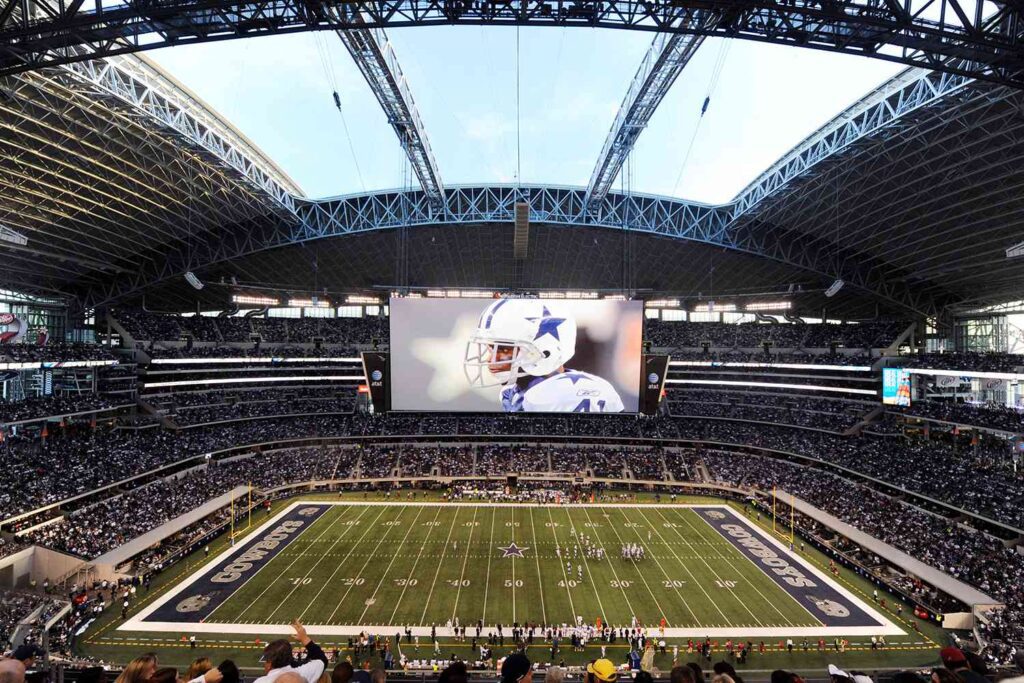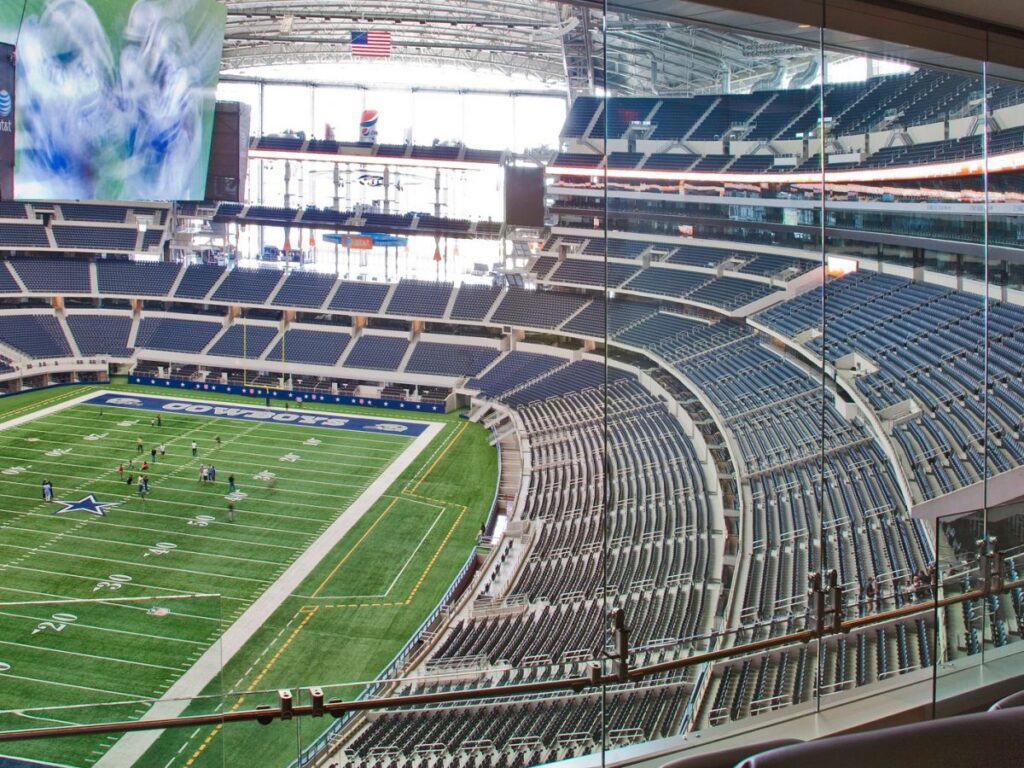The story of Cowboys Stadium, now known as AT&T Stadium, is one of ambition, innovation, and controversy. As one of the most expensive sports stadiums ever constructed, the $1.2 billion facility stands as a lasting symbol of how Cowboys Stadium financing blended public and private resources to create a modern sports and entertainment landmark.
Yet in 2025, the Dallas Cowboys once again find themselves mired in a disappointing season, continuing the struggles that plagued them in 2024. This downturn on the field raises renewed questions about the broader financial ecosystem tied to the stadium. When the team fails to deliver playoff football, the ripple effects extend well beyond the scoreboard—impacting ticket demand, local businesses in Arlington, and the long-term sustainability of a financing model built on consistent fan engagement and event revenue.
The Public and Private Contributions
AT&T Stadium was financed through a mix of public and private funding, with the city of Arlington playing a significant role in its development. The city contributed $325 million through bonds paid for by a half-cent sales tax increase, a 2% hotel-motel tax hike, and a 5% car rental tax. These taxes, categorized as “user taxes,” place the financial burden on those who directly benefit from the stadium’s operations, such as attendees and tourists.
Despite concerns about relying on local taxes for such a massive project, Arlington’s approach has exceeded expectations. In its first year, the city raised $27 million through these taxes, far surpassing the $20.4 million needed to cover its debt payments. This financial success was bolstered by the Cowboys’ stellar ticket sales and parking revenue, which outperformed initial projections.
The Cowboys themselves shouldered a significant portion of the stadium costs, with $875 million funded privately. To assist with this, the team implemented a 10% ticket tax and a $3 parking fee. Interestingly, these user taxes generated $15.2 million in the stadium’s first year, exceeding the original projection of $9.3 million.
Why the Financing Model Worked
The financial model for Cowboys Stadium succeeded due to conservative projections that underestimated attendance and ticket prices. For example, the stadium was projected to host 70,058 fans per Cowboys game at an average ticket price of $83.80. In reality, attendance soared to 86,990 per game, with an average ticket price of $159.65. The Cowboys also hosted major events such as soccer matches, which attracted nearly 70,000 attendees—double the expected turnout.
By tying much of the debt repayment to user taxes, Arlington minimized the financial burden on residents who do not directly benefit from the stadium. This model also created a revenue stream that scaled with the stadium’s success, ensuring that the Cowboys and the city both stood to gain from higher attendance and ticket sales.
The Cowboys’ Struggles in 2024
Fast forward to 2024, and the Dallas Cowboys are facing one of their most challenging seasons in recent memory. With inconsistent performances and mounting injuries, the team has fallen well below expectations, sitting near the bottom of their division. Their hopes for a playoff run have all but vanished, marking a stark contrast to the optimism that surrounded the team in previous years.
This lackluster performance has far-reaching implications, especially for AT&T Stadium. The playoffs are a lucrative period for NFL teams, generating significant revenue from ticket sales, merchandise, and concessions. Without a playoff appearance, the Cowboys are missing out on millions of dollars that could otherwise help sustain their financial commitments and boost the local economy.
Draft Fallout and the 2025 Season
The Cowboys’ disappointing 2024 campaign did lead to a high draft pick in 2025, but the immediate turnaround fans hoped for has yet to materialize. While the franchise added young talent with long-term upside, rookies rarely deliver instant results at the NFL level. The 2025 season has therefore begun much like the last, marked by inconsistency, lingering injuries, and a fan base growing restless.
Instead of serving as a quick fix, the draft has highlighted the slow, uncertain nature of rebuilding. As a result, concerns are shifting from on-field performance to the broader financial ecosystem tied to Cowboys Stadium financing, where revenue is closely tied to excitement around the team. Early signs of stagnant attendance and more cautious spending on tickets and merchandise suggest that the missed opportunities of 2024 are carrying over into 2025.
How Losing Seasons Erode Profits
For the Dallas Cowboys, success is about more than wins and losses—it’s about protecting one of the most valuable brands in professional sports. AT&T Stadium hosts concerts, college football, and other large-scale events, but Cowboys games remain the heartbeat of its financial engine. When the team falters, the ripple effects are immediate: lower ticket demand, reduced merchandise sales, and diminished enthusiasm among sponsors.
Missing the playoffs two years in a row is especially costly. Postseason games not only bring in premium ticket pricing and packed suites but also drive regional economic surges in Arlington. Without that boost, the franchise and the stadium lose millions in potential revenue. Fan frustration also begins to wear down loyalty, making it harder to sustain premium pricing for seats, suites, and sponsorship packages. For a team that built its stadium financing model on robust user-driven revenue streams, continued mediocrity poses real risks.
The Broader Economic Impact on Arlington
The struggles of the 2025 Cowboys season extend beyond the franchise itself. AT&T Stadium is a cornerstone of Arlington’s economy, drawing in visitors who fuel hotels, restaurants, and retail. A winning Cowboys team transforms the city into a regional hub of energy and spending, while another losing season dulls that impact.
The absence of playoff football for two consecutive years has been particularly damaging. Local businesses are missing out on high-spending postseason crowds, while the city loses a key driver of tax revenue tied directly to stadium activity. These ripple effects highlight both the benefits and risks of Cowboys Stadium financing: when the team thrives, Arlington reaps rewards, but when the Cowboys stumble, the economic model feels the strain.
Looking Ahead: Opportunities and Challenges
Despite back-to-back disappointing seasons in 2024 and 2025, the Dallas Cowboys remain one of the NFL’s most powerful franchises, supported by a massive national fan base and the world-class infrastructure of AT&T Stadium. The immediate challenge for ownership and management is to rebuild confidence—both on the field and in the marketplace. That means turning young draft picks into contributors, keeping key veterans healthy, and re-engaging fans who are beginning to question the team’s ability to contend.
Off the field, there is opportunity to diversify stadium-driven revenue. AT&T Stadium has always been more than a football venue, hosting concerts, international soccer, and other marquee events. Expanding this portfolio will be critical if the Cowboys want to soften the financial blow of another playoff miss. Community outreach and creative fan engagement will also be key in sustaining loyalty through a rebuilding phase.
From a financing perspective, the model behind Cowboys Stadium financing continues to stand as a blueprint for future public-private partnerships. The balance of city-backed user taxes and privately funded contributions has proven effective at minimizing risk for Arlington taxpayers while aligning the city’s fortunes with the stadium’s success. However, the Cowboys’ recent struggles underscore that even the best-designed financing models remain vulnerable to swings in team performance.
The Cost of Success and Failure
The story of Cowboys Stadium financing is ultimately a case study in both ambition and risk. Careful planning and innovative revenue streams made one of the most expensive stadiums in sports history possible. Yet the Cowboys’ back-to-back struggles in 2024 and 2025 reveal the downside of tying so much economic activity to a single team’s success. Without playoff appearances, the loss of high-revenue games ripples through Arlington’s economy, from restaurants and hotels to tax receipts meant to service stadium debt.
At the same time, the Cowboys remain the NFL’s most valuable franchise, and a return to winning seasons could quickly restore lost momentum. The financial framework that built AT&T Stadium has already proven its resilience during downturns, but the coming years will determine whether it can sustain long-term growth in the face of fan frustration and on-field inconsistency. In this way, Cowboys Stadium continues to serve as a living lesson in resilience, adaptability, and the complex intersection of sports, finance, and community investment.
What Needs to Happen for Future Success
For Cowboys Stadium financing to remain a long-term success story, both the franchise and the city of Arlington must adapt to current challenges while planning for growth. On the field, the Cowboys need to translate their recent draft investments into consistent production, stabilize leadership, and regain the winning culture that drives ticket demand and merchandise sales. A playoff berth in 2026 would restore not only fan confidence but also the financial momentum that comes with postseason football.
Off the field, the organization must continue to maximize AT&T Stadium’s potential as a multipurpose venue. Expanding its calendar of concerts, international soccer matches, and other high-profile events can offset revenue dips from disappointing football seasons. Arlington, meanwhile, should focus on strengthening the local economy around the stadium—improving transportation, hospitality, and entertainment infrastructure to ensure that visitors spend more in the city before and after events.
Finally, maintaining strong community ties will be critical. Fan engagement initiatives, affordable ticket options, and visible investment in local programs can help keep the Cowboys brand resilient even when wins are scarce. By combining on-field improvements with a diversified event strategy and stronger community integration, both the team and the city can ensure that the massive investment behind Cowboys Stadium continues to pay dividends well into the next decade.





